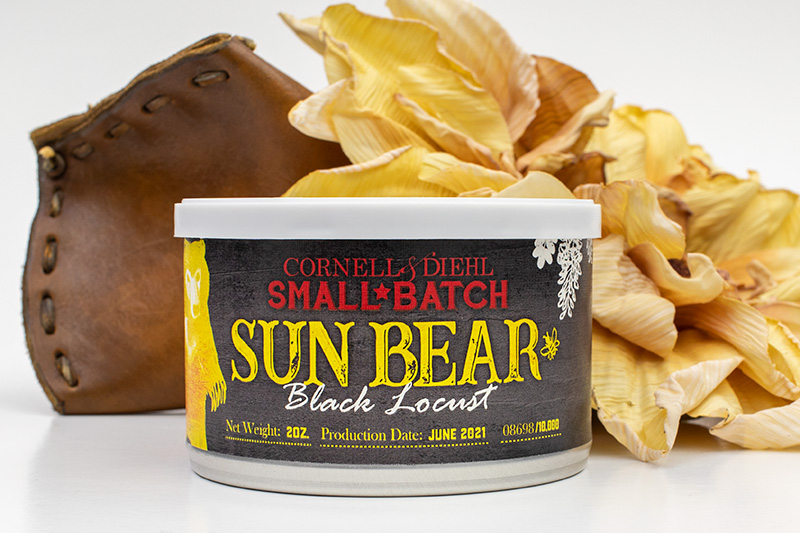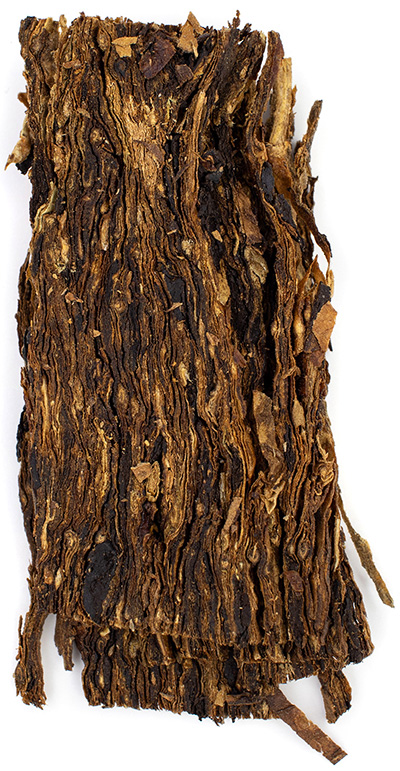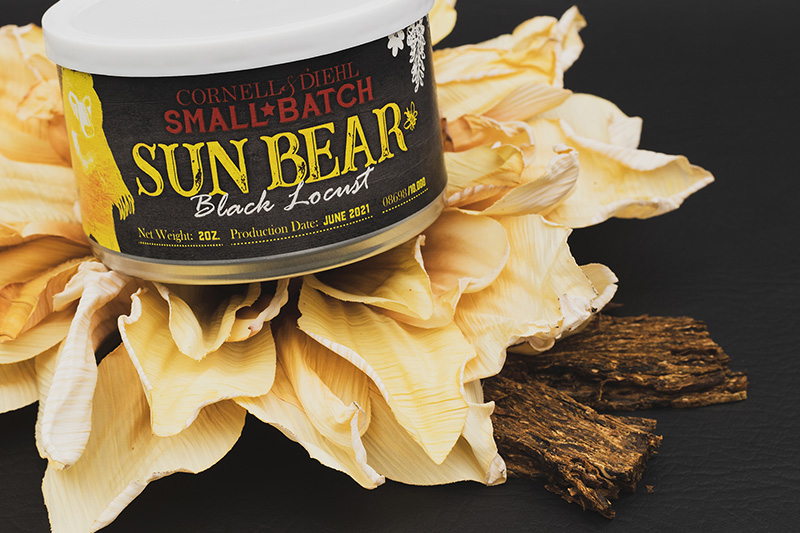The Fascinating Development of Sun Bear: Black Locust

Sun Bear: Black Locust will be available for purchase at 12:00am on Tuesday, July 20th.
Sun Bear, among Cornell & Diehl's most popular Small Batch compositions, is returning. It's a blend of Bright and Red Virginias balanced by Basma from 2014 and Izmir from 2013, with the subtle, whispered notes of silver tequila, elderflower, and honey. The original Sun Bear featured honey harvested from the hives of Jeremy Reeves, head blender for C&D, and his girlfriend Hillary. Jeremy was realizing that their hives this year were under producing when Victor Seested, a beekeeper in Maryland, happened to call.
Victor is a pipe smoker. He also does cut-glass crafting, including Tiffany lamp recreations with lamp bases cast from originals and as many as 1500 individual glass pieces. He's a retired financial planner and is detail oriented, as his recreational pursuits indicate. Bee keeping and pipe tobacco are among his passions, so when Sun Bear was released, he was particularly enthusiastic, and thought immediately about his bees' very special harvest from the black locust trees in Maryland.
"I'm always looking for new tobaccos," says Victor. "When C&D did Sun Bear, I think I got probably three tins, and when you opened up a tin, it was phenomenal. The fragrance was fantastic and it also smoked extremely well. So, anyway, the tin labeled it, the honey came from Jeremy's hives. I figured he's in a particular part of the country where his bees, at that time, brought in whatever was mostly in bloom to make the honey that he used. I've been a beekeeper for about five years now, knowing what the bees produce, and black locust honey is not like your typical honey. It depends on how well the trees produce in a given year, and that varies enormously, on top of a short blooming period. You may get a good bit of it in one year and not much the next year. I just thought, 'Hey, I'll give him a call.' One thing led to another and that's where we are today."
"The fragrance was fantastic and it also smoked extremely well"
The new formulation for Sun Bear was causing Jeremy some problems when Victor called him to talk about tobacco and bees. Jeremy couldn't produce the honey necessary for a new run of the tobacco, but during that conversation he learned that Victor could. And it wasn't just any honey: this would be honey from the Maryland black locust tree blooming.
"There's a little bit of a citrusy kind of tang," says Jeremy. "It's not the same tartness that I experienced from our honey." He and Hillary attribute that tanginess to the prevalence of hot peppers in their garden. "Victor's is more citrusy. But the focus of the flavor is definitely much more on these kinds of delicate floral notes. It's definitely sweet, but not as overpoweringly sweet as some honeys can be. It's wonderful in tea and delightful to drizzle over some berries and yogurt."
The honey is a small part of the blend and its high quality, light color, and purity will fall below the perception of most of us, but it's a significantly interesting element and emblematic of the care taken in C&D's blending and the components so carefully chosen for each application. It's an intriguing part of the blend, not only because honey is such an interesting product in its own right, but because bees are fascinating and their contribution to Sun Bear is notable.

Black Locust Tree in Bloom
Bees Are Smart
Bees are not merely little robots programmed to survive and make honey; they may possess consciousness and rudimentary self awareness. Bees perform higher-level cognitive operations than the size of their brains should allow. Until recently, scientists have identified consciousness through observations of behavior, but insect behavior is not like human behavior. According to an article in The Conversation:
Neuroscientist Björn Merker has argued that the capacity for awareness in humans depends on structures in the midbrain alone.
The midbrain is the evolutionarily ancient neural core that our enormous neocortex surrounds like a thick rind. Self-awareness requires our evolutionarily young neocortex, but awareness is supported by the simpler and evolutionarily much older midbrain.
Why is the midbrain so important? Once animals started moving around in their environment, they had to decide where to go next. Deciding efficiently requires combining many different sources of information into a single neural model with a single perspective on the world.
Tying together knowledge, desire and perception in this integration is the start of a first-person perspective on the world, and thus the origin of conscious experience.
That's not to say that bees are self-reflective the way humans are. But it does mean that science is starting to understand that bees perform much more complex tasks than they should be able to. They figure out some pretty complex computations, as well. Their brains are small but 10 times more dense than the brains of mammals.
...bees perform much more complex tasks than they should be able to
Bees can identify and remember landmarks and find the most efficient routes to food sources, and then take alternate routes back to the hive. They're the geniuses of the insect world, capable of abstract thought, detailed planning, complex navigation, and they understand time. According to Catherine Giordano in the article, "How Smart are Honey Bees," (2017), "They may be capable of cultural transmission. Experiments have shown that when one bee was taught to pull a string to get a sugary reward, another bee learned the trick just by watching the first bee. Even more surprising, they could teach this trick to other bees."
Unlike other insects, bees are symbolic, utilizing body language and dance to communicate very specific information, like the location and distance of bountiful flowers.
"The cells that bees make in the comb are hexagons," says Victor. "Hexagons are the most efficient shape for storage. I mean, why didn't they come up with circles, or rectangles, or squares? Hexagons are the most efficient. No wasted space. Another fascinating thing is, when they build the comb, if it was flat, they could not fill it up with the liquid honey. So, the bees build the comb with the cells at a 13-degree angle, tipped upward so the cells can hold honey."
Astonishing Productivity
Bees don't live long. A queen will survive for three or four seasons and accomplish much in that time. "She's most productive for maybe two or three years," says Victor. "She can lay upwards of 2,000 eggs a day. While she's laying 2,000 eggs a day during, say, spring and summer, you have maybe 1,000 or more bees dying each day. But if she lays 2,000 eggs and a 1,000 bees die, that's a gain of 1,000 bees every single day. So, a hive coming out of the winter is going to be small. It is small because they entered the fall/winter wanting and needing to save food stores. But when they come out of winter, and the queen starts laying eggs, you may have 15,000 bees in a hive, could be 20,000. But very, very quickly you can go from a hive coming out of winter with 15,000-20,000 bees to where a month later you've got 50, 60, maybe 70,000 bees in a hive. They just explode in population."
That increase in bee population is to take advantage of nectar harvesting season, which is quite short — in the case of the black locust honey used for Sun Bear, only a couple of weeks. "The nectar flow," says Victor, "is when the plants, whether flowers, trees, or clover, are producing nectar, which the bees will gather and turn into honey. The nectar flow varies depending upon geographic location. Maryland probably has one of the shortest nectar flows. It may be two months, give or take."
"Maryland probably has one of the shortest nectar flows"
The end of the nectar season is called the Dearth, and with the end of harvesting, the queen begins laying fewer and fewer eggs. Typically, by the time November or December arrives, no eggs are being produced. "An interesting fact for me," says Victor, "is that the bees born in the spring will live maybe four or five weeks. The bees that are born in the later part of the summer or early fall will live four, five, maybe six months. It all goes back to bees making and storing honey as a food source to get through the winter to the next nectar flow."
Lifespans for worker bees depend on when they are born and their particular responsibilities. Those born in the summer have a heavy workload and they live only weeks, but those born later can live months through the winter by slowing their metabolisms in the wait for spring. Drones — the male bees — live as long as the worker bees will put up with them, which isn't usually very long. They have no purpose except to mate with the queen, and will die shortly afterward if they do mate. Those who fail to mate with a queen return to the hive until the workers either kill them or force them out to fend for themselves — because they are quite simply a drain on supplies. The drones cannot live on their own, starving or freezing to death. Victor says it's a pathetic thing to watch when drones are forced out and they haplessly fly into things until they expire.
The bees adjust the population of the hive seasonally and to account for food availability, and the honey stored is the food source to last the hive through the winter. Young workers clean the hive and have nursery duty, feeding the larvae on "royal jelly," a secretion from glands in the heads of worker bees, which decides the future of the young. Those larvae fed exclusively on royal jelly become queens; worker and drone bees receive royal jelly for three days and then workers are fed "worker jelly" and drones are fed a modified diet combining worker jelly with increased proportions of pollen and honey.
Bees somehow decide the correct population for workers, drones, and queens, and plan for it by deciding what and how much to feed their young. Workers have many jobs, and it's their age that decides their tasks. They graduate from nursery duty when the glands that produce royal jelly begin to atrophy. Rather than retire, like their male counterparts so quickly do, they move on to building comb cells, then they start receiving and processing pollen and nectar from incoming forager bees, and toward the end of their life cycle become foragers themselves. While some tasks in a hive are dependent on the type of bee, most are a result of seniority.

Jeremy Reeves and his girlfriend Hillary inspecting their hives
Sustainable Beekeeping
Obviously, bees are complex creatures. Research continues and the more we learn, the more impressive these animals become. For those who keep bees, there's a responsibility to care adequately for them. Many smaller, amateur beekeepers lose substantial numbers each year (bee clubs report losses as high as 50 percent and more annually), and sometimes bees simply abandon a hive. However, constant upkeep is necessary for proper feeding and for keeping parasites in check. It doesn't take much neglect for a colony to be harmed.
Often, beekeepers will replace lost hive populations by purchasing more bees. Sustainable beekeeping favors splitting current hives and letting the populations grow more naturally. As for commercial beekeeping: it can in some circumstances be devastating to the bees. Almond trees, for example, require bees for pollination and those bees are transported, losing significant numbers of bees in the process, on top of those that die from the pesticides necessary for almond production. Up to 70 percent of commercial bees are transported for pollination purposes, and the loss of bees for this pursuit is devastating. Some almond milk is now labeled to indicate ethical production, a nice move forward for ethical beekeeping.
Many bee enthusiasts plant clover and other plants everywhere they can to help the bees. Jeremy and Hillary, for example, maintain a substantial garden and live where the bees can forage freely. Honey takes on different flavor qualities according to the pollen and nectar available to the bees. Sun Bear takes advantage of that natural characteristic.
Honey takes on different flavor qualities according to the pollen and nectar available to the bees
The Passions Behind Sun Bear

"Pipes, pipe smoking, and pipe tobacco have been a passion for me," says Jeremy. "And now I make my living creating pipe tobacco, which is really amazing. And I make my living creating it for my favorite American tobacco maker, the company that has made up the majority of my cellar for most of my pipe smoking days. But I'm also passionate about the environment and sustainability. Bees are a big part of that to me. So it was really a new experience to me to be able to take something that was important to me outside of pipe tobacco, and incorporate that into a pipe tobacco format. It's a unique experience. I love it. I love that this is what I get to do."
Sun Bear is a Virginia and Oriental mixture. "I really crafted it to be evocative of warm-weather smoking and to suit warm weather flavor-wise and palate-wise. But also to kind of be evocative of some of the aromas and flavors that I associate with spring and summer. I wanted to do that by using our honey, and this year, we're using a new honey: real, unprocessed, straight-from-the-hive, natural honey to emphasize the natural, sweet, fruity, and floral elements of the tobaccos in the blend. So I put together the tobacco recipe portion of this first and then crafted a casing around that recipe."
While honey is an essential element of that casing, so is alcohol. "It's white tequila," says Jeremy. "It has a little tartness. It has a little of that vegetal quality, but overall it's not really making a major impact other than to kind of evoke the tanginess of the Virginias.
"The honey that we've used in the past from my hives is deep and rich in flavor and has a touch of floral tartness, which is really interesting. This year we're using a different honey and this honey is also unique, really special. It's lighter in color. It doesn't have quite the tartness that we've always had in the honey that Hillary and I produce. I'm struggling to really describe it. It is still fruity, but it is much more focused on the floral element. It's almost white; it does have a golden tone to it, but it is really, really light compared to what we think of when we say something is honey colored."
"...real, unprocessed, straight-from-the-hive, natural honey to emphasize the natural, sweet, fruity, and floral elements of the tobaccos in the blend"
Sun Bear is more focused on the bright leaf than on the red. "What this black locust honey will do is accentuate the tartness to the smoker a little less than the previous honey did. It will bolster the sweet aspect of the Virginias quite nicely. And it will also emphasize the floral elements that you get from the Orientals. I find it to be just the slightest bit tangy and fruity and floral. And the tobaccos that make up the base are driving that character. The casing is just accentuating and solidifying those flavors."
Sun Bear: Black Locust will be available for purchase at 12:00 a.m. on Tuesday, July 20th. This latest run of the Small Batch blend is a labor of love combining the interests, skills, and pursuits of people who cherish tobacco and the wonders of nature. With top-tier Bright and Red Virginias, aged Orientals, and casings of silver tequila, elderflower, and raw, unpasteurized honey ethically produced in 2020, it's a smoke that not only evokes the experiences of summer, but embodies the natural elements of summer and combines sustainable beekeeping with knowledgeable blending and quality components to reveal a flavor profile to make the summer of 2021 memorable.











Comments
I've let honey bees drink soda off of my finger since I was a kid, I find them fascinating. I get mad when I see people panic and swat at or kill them. I have much respect for nature and appreciate learning something new about bees in this article. I still have some tins of Sun Bear cellared away, I wonder how much time or age before the honey starts to dissipate? Love the blend by the way, and really like the tin art for both. Thank you, Jeremy, for being a responsible beekeeper and creating these blends.
Once I got home, I got into the wine, got into the shower, I started thinking about the hexagon shapes that the bees shape/build in the hive and how it ties in to the Divine Proportion, PHI. There are certain mathematical patterns repeated throughout art, nature, and science. When I was living in SC (2005-2008), a book at Barnes & Noble caught my eye in the bargain bin. DIVINE PROPORTION/ PHI In Art, Nature, and Science. I'm looking at it now, the Fibonacci sequence is also present in the bee's breeding, along with rabbits. It is found in many things. I'll stop there, but if anybody wants to go further down the rabbit hole.
The bees aren't breeding with the rabbits, they share the same pattern: 1, 1, 2, 3, 5,, 8...🐝🐝🐝
Dunno Dan: Never heard about anaphylaxis? Between a sting and a swat, it's a no-brainer.
Great, another point to virtue signal. I didn’t know commercial beekeepers were either repacious creeps or wore halos. I’m sure glad C&D used ethical honey in Sun Bear. Whew. Now if only smoking pipe tobacco didn’t cause the planet to warm then I could face my EV driving friends with less shame.
@ William: I savvy anaphylaxis shock. I, however, am not allergic. And in a life and death situation, I can empathize with the killing of a bee. In my experience, I have never had a bee go out of it's way to sting me. I did read a story about wasps in Britain getting drunk on fermited fruit or thrown out pub cider, and going on stinging frenzies and targeting people. I just don't squash a bee out of fear, speaking on my behalf.
* fermented
On a sunny summer day back in the early fifties on the shore of Wisconsin's beautiful Lake Geneva, to my chagrin I realized I had just sat down on or adjacent to a bee hive. Suddenly my bare arms and face were covered with a mass of angry swarming stinging bees. I Instinctively swatted and rubbed my attackers off my face and arms and ran away from the water's edge, fortunately only having to endure a very painful, feverish few hours' bedrest thereafter. Although I regret the experience now, no bees have ever stung me since, I still love honey today, especially with butter on toasted English muffins for breakfast, and in a few tobacco blends as well. I hope to buy a couple tins of Sun Bear before SPC runs out this time around. Apologies and praise to all bees everywhere and special mention to Jeremy Reeves and Chuck Stanion, two extraordinary men.
@Thomas Johnson: Glad to hear that you survived that experience. There have been people killed here in Texas from swarms of Africanized honey bees that are protecting their colony. I've been an outdoors person most of my life i.e., grew up hunting and fishing, started framing houses thru my summer vacations when I was 14, ran around barefooted as a kid (stepped on some honey bees and have been stung a few times), and I have an outside job now where I have witnessed bee swarms (which can be scary). In my life experience, I have never had a bee just land on me and sting me for the hell of it, it also means certain death for the bee to lose it's stinger... which is a no brainer for the bee.
I can't remember a new tobacco that came into production in recent history that truly offered a new flavor to me like Sun Bear did. I'll do a horrible job trying to explain... it's like you basically have an idea of what an English blend is, what Virginias and VA/Periques are like, what classic Burleys are all about, or how non-aromatics and aromatics differ, ...but then there's Sun Bear. There's nothing close to similar to use for comparison when trying to explain what it's like. You can try to explain how the components share in the overall experience, but even that doesn't quite impart the flavors of Sun Bear. There are other VA/Orientals, but not one like Sun Bear. There are other tobaccos infused with booze, but not one like Sun Bear. Honey is no stranger to pipe tobacco, but it never tasted as it does in Sun Bear. I'm all giddy hearing and thinking about the Black Locust edition. It very much sounds like it'll still be Sun Bear, but that Victor's Maryland Honey will offer another completely different take on Sun Bear while still holding on to what makes Sun Bear so special. Jeremy Reeves created something altogether new and fresh to the world of pipe tobacco with Sun Bear. It sounds like he is about to do it again. To get to read this impassioned history and innovative story in the Daily Reader is a real pleasure. Thank you, Chuck.
I found my open tin of Sun Bear this morning, it's over a year (maybe 2 yrs old) and has been in a zip lock baggy. I can believe how moist it still is, and just as delicious. I'm giddy too!
*can't believe. When I have a number of open tins, I find that keeping the tin in a Ziploc bag maintains moisture and freshness.
080119/ Almost 2 yrs old. Still fresh!
Who other than Dr. Stanion could educate on bees and pipe tobaccos at the same time?
Twas the night before Sun Bear🌞🐻🐝 when all through the house not a creature was stirring. Not even a mouse. "I'm stirring and I'm a mouse."-Speedy Gonzalez. My pipe socks were hung by the chimney with care, in hopes that Sun Bear: Black Locust would soon be there. I woke from a deep sleep, for I had dozed off! I looked at my phone and panic set in, it was two tweny two in the A.M. I pulled up the site and much to my surprise, it was still available right before eyes. I ordered 5 tins and a pipe to boot. I let out a grateful sigh as I looked at my pup, thank you Smoking Pipes for the heads up!
@Dan- Nice!!
Thank you, Mountain Guerilla. This Small Batch sure did create a Big Buzz, lol.
Yes, quite an uproar.
Sooo....is this available for sale?
@Todd: My local Walgreens is currently stocked up. You might want to check Walmart, also, and dare I say it...Tobaccopipes was letting 1 tin go at a time for a few dollars more.
A great detailed write-up on bees and Sun Bear. Looking forward to trying it this evening.
This is your best article, very well done. The links have given me new science and nature websites to explore. Bees are incredible and important creatures.